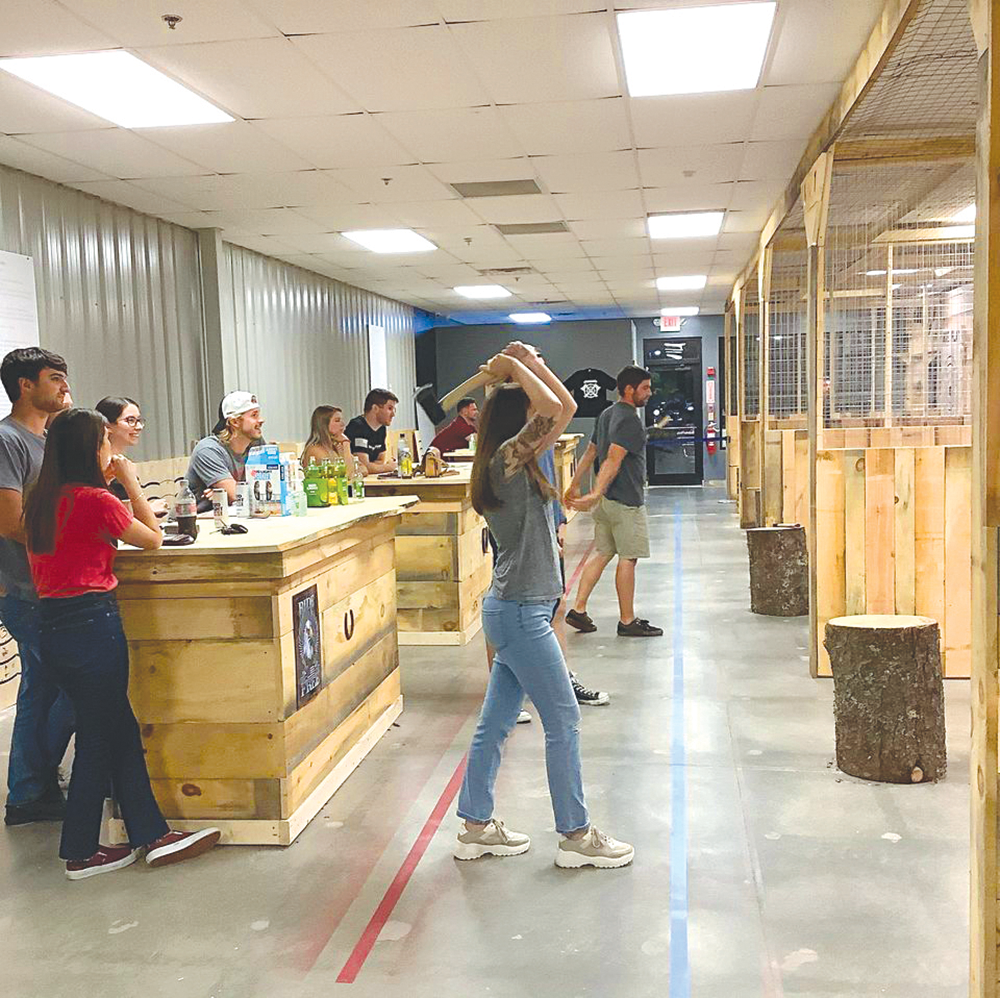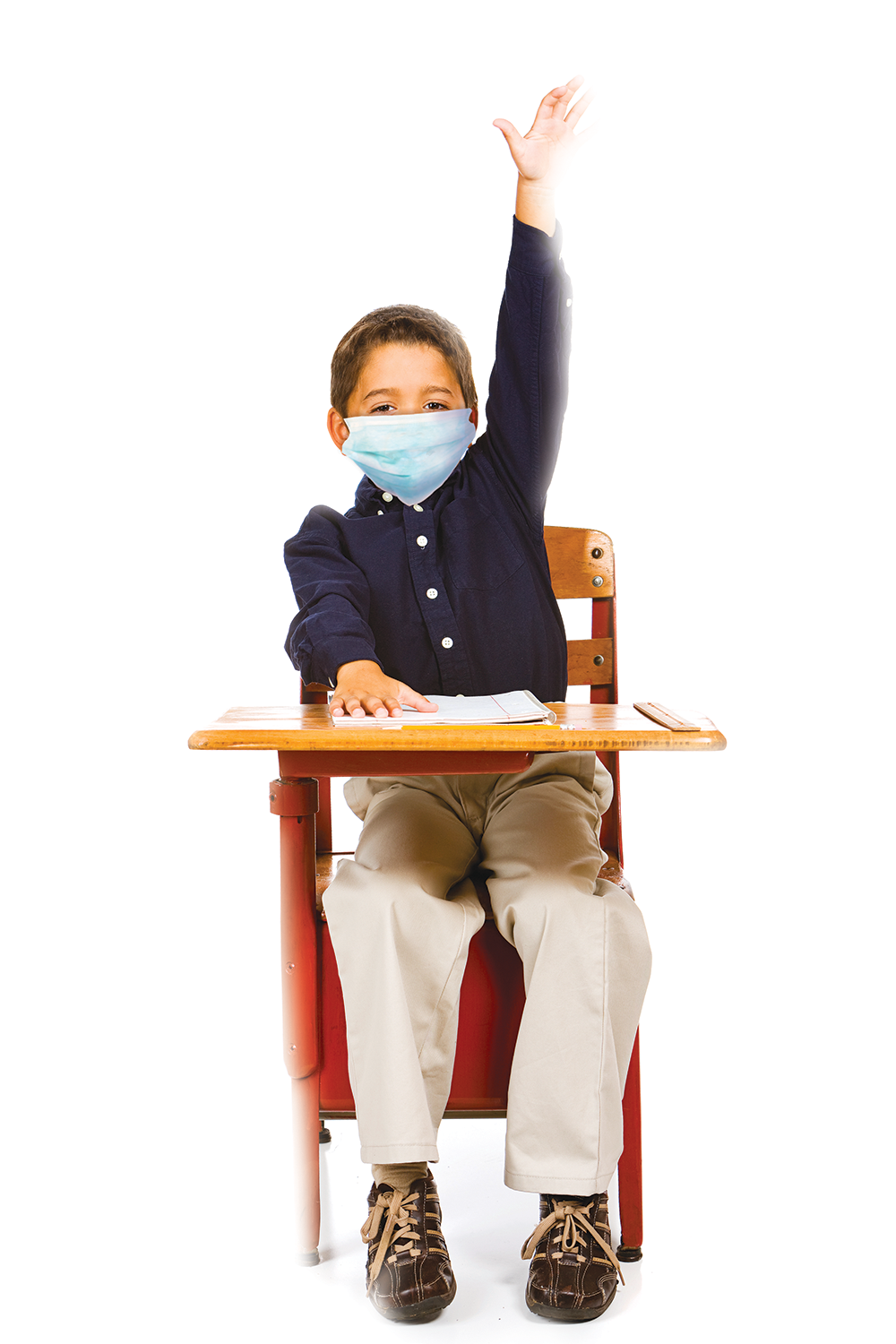Experts talk about the new school year and what parents and students can expect
Students in New Hampshire are heading back to school — sort of.
As districts kick off the 2020-2021 year (some this week, some after Labor Day), New Hampshire schools are operating with a mix of strategies and schedules: some districts are returning to fully remote learning, some have returned to all (or most) students being in a school building and some are operating on a hybrid system.
Over the last couple of weeks, we reached out via email and phone to school officials at several southern New Hampshire school districts looking for administrators and teachers to comment on their plans. We didn’t receive a response from many districts, including Nashua, Manchester and Concord. Some that did respond declined to comment, a few citing lack of time.
We spoke to New Hampshire Department of Education Commissioner Frank Edelblut as well as some educators and a school nurse (who all responded to emailed questions) about how they’re planning for next year.
Frank Edelblut
Commissioner of the New Hampshire Department of Education
What are some of the approaches schools are taking to reopening this fall?
We put a survey out and got 56,000-plus [responses] from families, teachers, administrators and wellness providers, so we got a good sense of what the field was thinking as we began to approach the fall. … The primary focus was on how we can safely bring our students and our staff back into the buildings for in-person instruction, and we realized right away that we could probably do it safely, but maybe not for everyone. There are going to be individuals, whether those are staff or children or members of families, who have underlying health conditions that would prevent them from re-engaging in that in-person instructional model. There is still going to be a lot of uncertainty around the coronavirus and how it might present itself in our communities. So, we recognize that we need to have a certain amount of flexibility and nimbleness in the system so that we can provide a continuity of instruction for the students, whatever the circumstances are. … It’s not likely that we’re going to open in September with one [education model] that stays the same as we go forward. It’s more likely that the circumstances are going to be dynamic, and that we will have to pivot from in-person, to hybrid, to remote, and back again.
Are many families shifting to home schooling or transferring to different schools because of their current school’s reopening approach?
There are many different reasons that a school district’s particular plans may not work for certain families. Some families may have [a person with] an underlying health condition. Some families may have two parents who work and need child care for their young children. … We have seen an increase in the number of families that are applying to home-school their children, but it’s not a significant number. … More often, we are seeing families working with their school district to say, “How can we work together to come up with something that’s going to meet the needs of our family?”
What will in-person learning look like now?
It’s going to be a little bit different at each school, depending on their individual strategies, but generally, you’re going to see social distancing, face masks, cleaning protocols and screening individuals before they enter the building. As [State Epidemiologist] Dr. Chan says, there’s not one mitigating strategy that’s going to be 100 percent foolproof, but if we layer various mitigating strategies on top of one another, hopefully we’ll be able to efficiently and effectively mitigate the spread of coronavirus so that our staff and our students are in a safe environment.
What did you learn from doing remote education last spring, and how will it be improved this academic year?
We learned a lot. … No. 1, we learned that the remote instruction model isn’t able to meet the needs of some of our students. That includes some of our most vulnerable students who have individualized education plans and need some in-person instruction and support around that. … Along those same lines, there is a need for students in career and technical education programs like auto mechanics and welding, who rely on hands-on instruction, to be in a laboratory environment. … The last group this applies to is some English learners, who had a little bit more difficulty accessing the [remote] instruction. … The second thing we learned is the importance of making sure districts have the [remote learning] technology and are able to use that technology to create a more consistent, higher-quality learning experience. In the spring there was a lot of variation in quality from one [class] to the next. You could have one instructor who had a high degree of capacity to pivot to that remote learning and another instructor who struggled with it. We were also offering a very inconsistent product. Students could have one class on Zoom and another class on Google Meet. … This fall we’re looking to really homogenize [remote learning] around a much better standard of delivery so that everyone gets a high-quality, enriching educational experience.
How are you supporting students who have fallen behind as a result of the sudden and major changes last spring?
The first way is to make sure they can have that in-person instructional experience [within a] system where it isn’t difficult for them to access their education. … The second thing we’re doing is working with our educators and families to bring those students in and do assessments to see, what do they know? What don’t they know? Was there any learning loss? If so, what was that learning loss? Then, we can look at how we can mitigate that learning loss … A lot of folks are really concerned about that learning loss. I don’t want to downplay the significance of that, but I’m not as worried about it, because I have a lot of confidence in our education system to fill in those learning gaps. That’s what our system does already. Every day of every year, when students arrive at school, they lack knowledge, and it’s our job to fill in those learning gaps. It’s what we do best.
How are you addressing students’ social and emotional needs?
[The pandemic] has been a traumatic experience for many adults as well as many of our children. We’ve talked a lot about the importance of making sure our students are socially and emotionally grounded. We can provide support for those children, particularly when we get back to in-person instruction, through relationship-building, so that they know us and we know them. Having that trusting relationship will allow us to more effectively engage with them.
What can parents do to help students thrive this year?
I think one of the most important things parents can do is be a calming influence in the lives of their children. Children respond to the demeanor and temperament of the adults around them, so if parents can remain calm and confident that we’re going to work through this, that’s going to help keep their children safe and not create any additional anxiety. … Then, I would ask parents to work with their children, especially young children, on the mitigation protocols. … Talk with them about washing their hands and what social distancing is. They may have an impulse to run over and hug their friends who they haven’t seen in a while; talk with them about how they can greet their friends in an appropriate way. Explain to them that things are going to be a little bit different this year so that they know what to expect when they show up to school. … In terms of academics, show a strong interest in your child’s learning. When parents show an interest and are engaged in their child’s academic studies, it becomes more important to the child, and they perform better. … I would also encourage parents to have a good line of communication with teachers and principals. Reach out and say, ‘How are things going? How can I help? What are the things I need to work on?’ Teachers will be able to give a lot of good feedback to parents to help them better support their child in this new environment. — Angie Sykeny
Linda Gosselin
Teacher and reading interventionist, Center Woods Elementary School in Weare, which will begin the school year on Sept. 9 with a phased-in approach until Sept. 22, during which time about a third of the student population will be in school buildings while the others will work remotely.
How are you planning to approach the start of this year?
I am looking forward to seeing the students again — it’s been a while. I plan on being positive and flexible this year, as there are a lot of unknowns. I hope to make any transitions that come our way as seamless as possible for the students. I think we have to approach this school year one day at a time, as we adjust to all the changes in what we do and what we have done.
How much back-tracking do you plan to do to catch kids up on last year?
For 28 years I have been a classroom teacher. I have taught kindergarten as well as first, second and third grade. This year I will be assuming a new position as a reading interventionist. The reading interventionists will begin the year, as they always do, assessing students to determine their strengths and weaknesses. We will then take that data to come up with a plan to work with students who have the greatest need for reading support and intervention. We will work with them on their weaknesses, build on their strengths, monitor their growth and adjust as needed.
What did you learn about remote teaching from last year and how are you going to apply that this year?
Last year, I spent a lot of time researching and learning about new technologies and ways to make remote learning engaging and fun. For example, one of the math lessons I assigned involved the students using a virtual flashlight to search a darkened room for hidden math facts. When the light of the flashlight revealed the math fact, the student recorded themselves reading the math problem and their solution. It was fun for the students, and it gave me a lot of information about the students’ number fact fluency. … I also learned that setting expectations and holding students accountable was important, especially once the novelty of remote learning wore off. This year, I would expand on that by setting a virtual positive reinforcement reward system to help keep my students motivated.
What do you think are the most important things for your students (skills to learn, emotional development, etc.) going into this year, and how are you addressing them?
I think as we begin this school year, social-emotional development is by far the most important thing. For me, that means being positive and upbeat in front of the students [and] letting them know … that we can get through this different way of doing things together while having fun and learning. Next, I think establishing routines is very important. Children do better when they know what is expected of them, and with all of the changes in routines this year, they will benefit from a lot of modeling and practice. Once day-to-day routines are well-established, the students will be better able to focus on learning.
What are the most important things parents can do to help kids with remote learning this year?
My advice to parents would be to present remote learning in a positive way to your child, regardless of how you feel about it. Remote learning will go a lot more smoothly if it is presented to children in a positive light. Also, whenever possible, try to establish some sort of structure and routine for your child. For example, establish a specific area in your house for schoolwork. That may be a little table and chair with good lighting in a quiet spot, or a certain spot at the kitchen table. If they are bringing home schoolwork, as in a hybrid model, they could have their learning “tools” in a zip-lock bag that is used just for schoolwork. Another suggestion would be to post a schedule, similar to a typical school day, making sure to include outside time as well as snack breaks. Parent involvement is key in remote learning. Checking your child’s work or asking a few questions about what they are working on not only shows them that their education is important to you, but it keeps them accountable. As a reading interventionist, I also have to add that reading to your young child every day is a routine that should be ongoing, whether remote or in school.
Karen Merill-Antle & Victoria Brown
School counselors, John Stark Regional High School in Weare, which will begin the school year on Sept. 9 on an alternating day hybrid schedule.
What do you say to parents who are worried about how the impacts from the pandemic are going to affect their kids’ ability to get into and succeed in college? How might your advice be different for freshmen versus seniors?
Colleges are going through parallel crises to that of the students and families. Some good news is that colleges are becoming ever better at their virtual options for students to learn about their school. However, it is not business as usual for admission offices and this may be the most important thing for students and families to understand. How one college is responding may look very different to another, and things may continue to change. NHHEAF [New Hampshire Higher Education Assistance Foundation] is a reliable and up-to-date resource for students and families. … We want students to know that there is no need to feel overwhelmed. Student decisions now are about where to apply, and those decisions can definitely be made virtually. … When it comes time for students to decide where to attend, there will be other options. What students must know also is that while some has changed, much is still the same. Colleges still want to see students taking a full load of the most appropriately rigorous courses. … While there are limitations to our current circumstance, it actually gives us a different way to view the student and help answer the following questions — How does a student respond to adversity? Is the student self-motivated and independent? Does the student have time management skills in place and can the student effectively self-advocate to have their needs met? These are all characteristics of a successful college student and our current circumstances gives our students the opportunity to practice and refine these skills. … As far as the freshmen, our message will be the same. They only have four years to build a beautiful transcript, reflective of their passions, tenacity and work ethic. For as we have learned, the future is unknown and so we simply do the best we can with what we have each day.
Michele Leclerc
School nurse at The Derryfield School in Manchester, which will reopen for in-person instruction, with the option for students to learn virtually.
What has your school been doing to get ready for the year?
The Derryfield School has been preparing for the 2020-2021 restart of school since last spring. We are reopening in the fall with the ability for all of our students to be physically on campus, and we have an excellent option for students to learn synchronously but virtually. We used the advice of consultants, who are public health experts with training in epidemiology, and guidelines from the State of New Hampshire and CDC to create health and safety protocols in our reopening plan. Our teachers have participated in professional development and updated curriculum to allow for an easy transition between in-class and online learning.
Are there specific common areas, like buses or the cafeteria, that are cause for the most concern? How are you addressing that?
At The Derryfield School buses will be at half capacity; students will have assigned seats and be prescreened, masked, and as distanced as they can be. Since that distance might not be six feet on some buses and ventilation on buses isn’t to the standard of the classroom environment, if a student or driver is positive for Covid-19, the whole bus group will be quarantined for 14 days.
What is the protocol if there is a coronavirus case at your school?
An extremely important part of our plan is the ability to keep students at home if there is any question about their health. If students are feeling well but need to quarantine, they are able to virtually participate in instruction using in-classroom technology. In the event our school needs to close the physical campus, we are prepared to switch all of our students to virtual learning.
How will you differentiate between influenza cases or normal colds and coronavirus?
Some of the symptoms of Covid-19 (temperature of 100 F or greater, chills, cough, shortness of breath, sore throat, nasal congestion, runny nose, fatigue, muscle or body aches, headache, new loss of taste or smell, nausea or vomiting, diarrhea) can be confused with colds or the flu. I highly recommend everyone get a flu vaccine this year, especially considering it may be hard to tell the difference between Covid-19 and the flu based on symptoms alone. Although policies may differ slightly between schools in the state, NH Grade K-12 Back-to-School Guidance says any person with any new or unexplained Covid-19 symptoms (even if only mild symptoms) should not be allowed to enter a school facility. The individual should contact their health care provider for a Covid-19 test and self-quarantine for 10 days from the onset of symptoms. Symptoms must also be improved and the student must be fever-free for 24 hours without fever-reducing medication before returning to school. If there is a confirmed case of Covid-19 in a school, extra cleaning and disinfecting should be done in all areas used by the person who is sick, such as classrooms, offices, bathrooms and common areas. If a member of a school community tests positive for Covid-19, New Hampshire Public Health will work with the school to begin contact tracing.
Are you getting the PPE that you need?
We needed to check with multiple vendors to order the quantity of supplies we anticipate needing, but we were able to order hand sanitizer, wipes, masks, gloves, thermometers and additional PPE. It was helpful that we started the process of ordering early in the summer. Many of these supplies are now backordered.
How will you handle Thanksgiving and Christmas breaks?
At The Derryfield School, classes will be taught virtually from Thanksgiving until mid-January. This will allow for family travel and visiting and also to quarantine before and after visits to keep loved ones and school community members safe. New Hampshire Grade K-12 Back-to-School Guidance says any person who has traveled in the prior 14 days outside of New England should not be allowed to enter a school facility and should self-quarantine for 14 days from the last day of travel. If a student has to travel at other times of the year, we will work with the family to transition the student to remote learning during their quarantine period.
What advice would you give to families about planning for this school year? What should we expect this fall and winter?
What to expect this fall and winter is somewhat unpredictable. It is likely there will be waves of increased Covid-19 infections in New Hampshire. I recommend being prepared for the worst-case scenario.
1. Prepare back-up plans now in case your child needs to be home because their school needs to go remote or your child needs to quarantine for up to 14 days due to possible exposure to someone with Covid-19.
2. Families should have a working thermometer as many schools will require temperature checks each morning before school.
3. Get hand sanitizer for your child to keep in their backpack at school.
4. Check with your child’s school regarding face mask policies. If you need to provide your own cloth masks, be sure the masks you get meet your school’s standards (WHO recommends cloth masks be three-layer).
5. Prepare your child by practicing mask wearing and social distancing (six feet recommended) in public spaces.
6. Prepare your child by practicing good hand hygiene. Wash hands for at least 20 seconds with soap and water. If hand washing is not ideal, use hand sanitizer (at least 60 percent alcohol).
7. Be sure your child has a flu vaccine.
Maureen Colby
English teacher, John Stark Regional High School in Weare, which will begin the school year on Sept. 9 on an alternating day hybrid schedule.
How did remote learning go for you and your students last year? What did you learn from it?
I definitely think that it went pretty well, even though it was a super-challenging experience for teachers and families. I’ve got 18 years of teaching under my belt and this was, by far, the most difficult time in my professional career. At first we weren’t sure how long we’d be remote for, so it was definitely hard to have that unknown hanging out there for much of the semester. … Not being able to see my students every day in person felt like a tremendous loss; however, I think that we — teachers and students — learned a lot about the importance of the relationships that we build with each other. One of the best things to come out of remote learning was being able to have virtual individual and small group conferences with students. Obviously, it’s not the same thing as in-person conversation, but being able to provide this attention really helped me to partner with my students so that I could help them to reflect on their progress, set meaningful goals, solve problems and talk about their learning. Time and again, I was blown away by my students’ honesty and insight. … I also think that we gained a better understanding of who we were as people. Sometimes it is easy for teachers to forget that a student comes to their classroom with an entire background that affects how they respond — for better or worse — in any given moment. Our backgrounds were there for all to see during this experience. … I have a five-year-old and there were many times [when] he would interrupt a virtual lesson or meeting. My students were so patient, kind and understanding whenever this happened. … Finally, I think that remote learning really highlighted how everyone learns differently, and how important it is for teachers to continue to use creativity to meet the needs of their learners. Obviously we know this … but it was a powerful reminder that we owe … to our students to provide relevant, rigorous and meaningful learning opportunities that appeal to a variety of interests and needs.
How are you doing things differently for the fall?
We will be using a hybrid model this fall. This will mean that students will participate in remote instruction for three days of the week and will meet for in-person instruction for at least two days a week, depending upon what letter of the alphabet their name begins with.
What do you say to parents who are worried about how all of this is going to affect their kids’ ability to get into and succeed in college? And how is your advice different for freshmen versus seniors?
First of all, I want parents to know that I understand this concern — and that we’re going to work really hard at helping students to develop the skills that they need to succeed in college and their careers. Obviously, we are facing a really challenging time in our country and our world, but I think that this circumstance is providing a lot of opportunities for personal growth. We are all in this together, but our success really depends upon everyone stepping up, taking responsibility and becoming engaged members of their communities. I know that I’m going to have to work really hard at helping my students to practice increased independence and accountability this year. When they are learning from home, I am going to have to trust them to work independently and to use their resources. … Our students have shown a lot of resilience and this is something that we are going to continue to work on. If we view this experience as an opportunity to develop independence, responsibility, resilience and communication skills, I believe that our students will be ready to tackle the challenges of college or their chosen career.
How can parents best help high school-level students with remote learning?
Making sure that students have a place to do school work is a great first step. I usually recommend that this isn’t in the student’s bedroom. Reviewing and posting a daily schedule with class meeting times, lunch and meal breaks, and time for exercise and recreation is helpful. A lot of high school students need support with executive function skills, so communicating the daily plan is a great way to reinforce these skills and to help students stay on track. Using a planner or a checklist also helps students to identify and manage what needs to be done. Lastly, encourage your students to reach out to teachers if they need help, have questions or are struggling. This really helps teachers to better serve their students — and it helps to build a trusting, supportive relationship between your student and their teachers.
— Angie Sykeny and Matt Ingersoll










